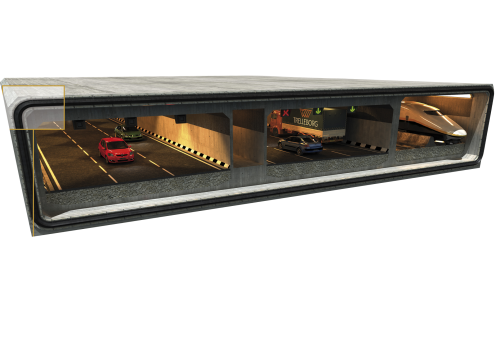

Interesting times
The urbanization of the planet is continuing at a breakneck pace. The population of the developing world’s cities grows by 5 million each month, and by 2050 it’s predicted that more than 70% of the world’s population will be city dwellers. Beyond the social and environmental implications, this trend is creating opportunities and challenges for the companies that build the roads, construct the high-rises and dig the subways of these booming metropolises.
“In the world’s growing cities you see wonderful architecture and structural engineering,” says Paul Gogulski, a US-based international construction consultant.
“They are pushing the limits, with innovative designs and use of materials. But 50-story buildings are going up in China in just 12 weeks, and the windows leak and the elevators don’t work. They will be slums in a decade. These are interesting times for the industry.”
Rail systems
Traffic congestion is a major issue in most cities, and the situation will only worsen as cities grow.
“The challenge is to move a lot of people in a congested space,” says Bruce Cage, Managing Director for engineered products in Trelleborg Offshore & Construction, Australia.
“With growing urbanization we are going to see more medium- and light-rail systems built in Asia and Australia. We are already seeing an expansion of the rail systems in Kuala Lumpur and Hong Kong.”
In Australia the number of urban light-rail projects has gone from zero to five in just a few years. Recently Trelleborg won the contract to supply rail support systems for the Gold Coast light-rail system.
“One of the issues in urban light rail is noise, and we provide noise-attenuating solutions,” says Cage.
India and China
When it comes to the construction equipment that does the heavy work of building cities, the market has largely stagnated in Europe and the US. But manufacturers of this equipment are establishing production in India and China, where urban populations are forecast to grow by 497 million and 341 million respectively by 2050.
“India and China have seen a slowdown, although from high levels, but there is still a positive trend in construction,” says Don Farbotnik, Global Market Manager for antivibration for specialist vehicles at Trelleborg Industrial Solutions.
Trelleborg supplies a large amount of products, from seals to cab mounts for the off-highway construction market.
“They are building a lot of urban infrastructure there, and the big construction equipment manufacturers have turned up.”
Britain’s JCB and Sweden’s Volvo have established themselves in India, as has Trelleborg, which recently opened a new facility in Bengaluru to serve these original equipment manufacturers and others in the Indian market.
“The future really does look good for the construction market,” says Farbotnik.
“People are cautious right now, especially in Europe, but you can only hold back development for so long. The projects for roads, buildings and bridges that have been delayed will need to be done sometime, and we are well positioned with our product line and our customer base to take advantage when the time comes.”
Protection for coastal cities
Rising seawater levels and more frequent and more powerful storms are creating a new set of challenges for coastal cities – challenges that could be addressed by massive construction projects.
To protect against the vast destruction wreaked by 'Superstorm' Sandy, some experts are proposing a sea barrier for New York harbor.
“This will definitely be an interesting business area because many cities are at risk,” says Ruud Bokhout, Sales and Marketing Director for infrastructure at Trelleborg Offshore & Construction.
“There are no standard solutions for these projects, so they will require the engineering competence and knowledge about rubber and its behaviour that we can provide.”
Gogulski says that although tough times lie ahead for the construction sector as a whole, some companies will thrive.
“Companies that innovate can still be very successful,” he says.
“And while countries’ economies fluctuate, international companies will be able to handle that, while many smaller firms won’t.”
Sealing dry
| We’re seeing an increase in infrastructure investments in the US. |
Renewed focus on infrastructure projects in the US is presenting new opportunities for engineers, contractors and suppliers. At a major tunnel under a river in Virginia, Trelleborg seals and gaskets are helping to keep the water out.
“We’re seeing an increase in infrastructure investments in the US,” says André de Graaf, a sales manager for infrastructure at Trelleborg Offshore & Construction in the Netherlands.
“For the past 20 years there was minimal interest from the US government in infrastructure investments, but with President Barack Obama, there’s been a lot of attention on them.”
In the state of Virginia, the city of Portsmouth sits across the Elizabeth River from Norfolk, the site of the largest US Navy installation. The two cities are connected by the heavily traveled Midtown Tunnel, which carries a million vehicles per month – seven times as many as when it was built 50 years ago. An emergency defense alert could cause gridlock as federal workers scrambled to reach the navy base, according to Craig Quigley, Executive Director of the Hampton Roads Military and Federal Facilities Alliance.
To avoid this scenario, a new tunnel is now under construction next to the old one, and the contractors are employing Trelleborg’s Gina gaskets and Omega seals to keep the river out.
“In the US, the Virginia project is one of several projects we expect to be involved in,” de Graaf says.
He acknowledges that getting into the US market can be challenging.
“Americans tend to choose American suppliers for their infrastructure projects,” he says.
Deliveries will take place from 2013 through 2015, and the tunnel is scheduled for completion in 2016. De Graaf sees a bright future for immersed tunnel projects in the Americas.
“People are flocking to cities, and the solution to mobility issues is to build tunnels,” he says. ♦


